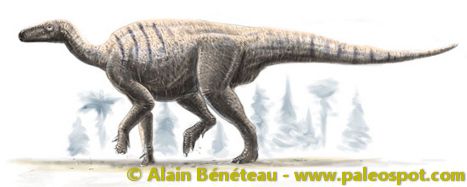-
 Speleology
Speleology
-
 Common broom
Common broom
-
 Cranium
Cranium
-
 Substitution
Substitution
-
 Hoar frost
Hoar frost
-
 Android
Android
-
 Pisolitic
Pisolitic
-
 Primary energy
Primary energy
-
 Fog
Fog
-
 BIOS
BIOS
-
 Fig
Fig
-
 M36
M36
-
 Omega-3
Omega-3
-
 One-way hash
One-way hash
-
 Cauliflower
Cauliflower
-
 Rosemary
Rosemary
-
 Point-to-point link
Point-to-point link
-
 Vector processor
Vector processor
-
 OCR
OCR
-
 Jitter
Jitter
-
 Taurids
Taurids
-
 Public domain software
Public domain software
-
 Diarrhoea
Diarrhoea
-
 SNAPI
SNAPI
-
 Bacillus
Bacillus
-
 Disruption
Disruption
-
 Graphite
Graphite
-
 Sporangium
Sporangium
-
 Ribonucleotide
Ribonucleotide
-
 Carminative agent
Carminative agent
Iguanodon
The second dinosaur ever discovered, the Iguanodon roamed the lands of Europe and Asia during the lower Cretaceous. The most well known species is Iguanodon bernissartensis, thanks to the discovery of about 26 nearly complete skeletons in the famous Bernissart mine in Belgium. The genus Iguanodon is currently being redefined. Some species now have other names: Barilium, Dollodon, Hypselospinus, Torilion, Wadhurstia…
In any case, these different species are characterised by a size of approximately 6 to 11 metres long, shorter front limbs than hind limbs, and a thumb with a large claw which was believed to be a horn during the first reconstructions. Some species were mostly bipeds, others were quadrupeds.
Since the 1970s, they are depicted horizontally, the "kangaroo" posture of previous reconstructions not being compatible with them being able to keep their balance when moving.

Reconstruction of an Iguanodon. © Alain Bénéteau
Latest
Fill out my online form.



